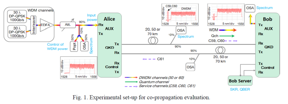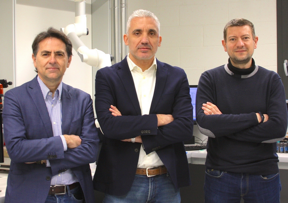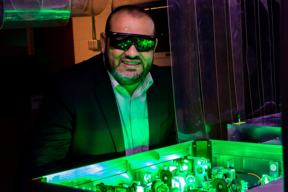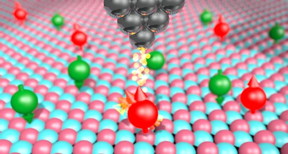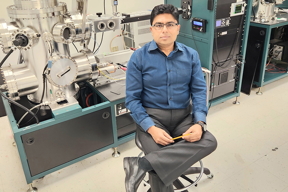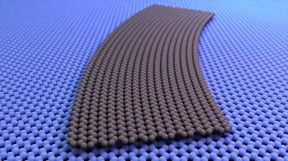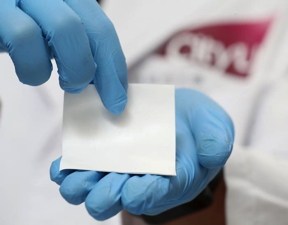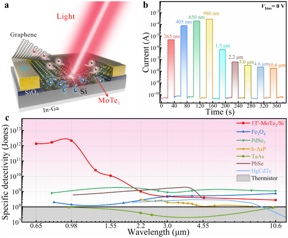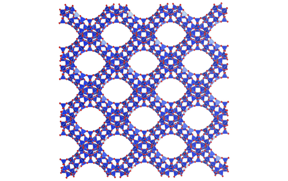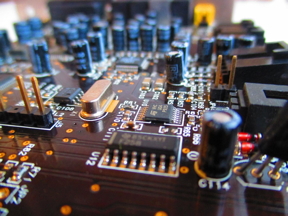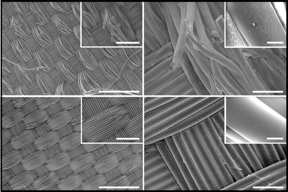Home > Press > Study demonstrates that Ta2NiSe5 is not an excitonic insulator international research team settles the decade-long debate around the microscopic origin of symmetry breaking in the bulk crystal
 |
| Characteristic electronic structure observed in candidate excitonic insulators. The shape of the electronic bands originates from the combined action of structural and electronic symmetry breaking. In Ta2NiSe5, the contribution of structural symmetry breaking is dominant and hinders any prospect of dissipationless energy transport. CREDIT Jörg Harms, MPSD |
Abstract:
The excitonic insulator is an electronically driven phase of matter that can occur in solids. Scientists are searching for ways to detect and stabilize this exotic order in candidate quantum materials because it could pave the way towards superfluid energy transport with no net charge (which is distinct from superconductivity). If realized, this phenomenon could lead to a new generation of devices where energy is transported at the nanoscale with high coherence and minimal dissipation.
Study demonstrates that Ta2NiSe5 is not an excitonic insulator international research team settles the decade-long debate around the microscopic origin of symmetry breaking in the bulk crystal
Hamburg, Germany | Posted on May 12th, 2023However, spotting this phase in real solids has proven difficult so far. For the past two decades, it had been proposed that the quasi-two-dimensional solid Ta2NiSe5 may support an excitonic insulator phase above room temperature. Above a critical temperature TC = 328 K, this material crystallizes in a layered structure that consists of parallel Ta and Ni chains. At TC, the system undergoes a semimetal-to-semiconductor transition, accompanied by a structural reorganization of the crystalline lattice. The scientific community has been engaged in an intense debate regarding whether this phase transition was induced by a purely electronic or a structural instability.
In a recently published study on PNAS, researchers in the U.S., Germany, and Japan probed the fundamental processes underpinning that transition via a joint experimental-theoretical approach. Using an advanced experimental tool called time- and angle-resolved photoemission spectroscopy under highly controlled conditions, they exposed Ta2NiSe5 to a tailored laser pulse and recorded a real-time movie of the fundamental components of the excitons (i.e., electrons and holes) as well as the structural degrees of freedom. To resolve these microscopic phenomena, the movie had to achieve an ultrafast time resolution of less than a millionth of a billionth of a second.
Tracking the dynamics of the material’s electronic and crystal structure after light excitation revealed spectroscopic fingerprints that are compatible only with a dominant order parameter of structural nature. This implies that the changes in the crystal structure actually hinder the development of electronic superfluidity in this quantum material.
“This work demonstrates that Ta2NiSe5 is not an excitonic insulator and that dissipationless energy transport is hampered by the prominent rearrangement of the crystal structure,” says Nuh Gedik, Professor of Physics at the Massachusetts Institute of Technology (MIT), who coordinated the research. “Our experiments provide a new approach to identifying the driving force behind spontaneous symmetry-breaking in a wide range of candidate excitonic insulators,” adds lead author Edoardo Baldini, former postdoctoral fellow at MIT and now Assistant Professor of Physics at the University of Texas at Austin.
The findings were backed up by state-of-the-art calculations at several institutions who combined different theoretical techniques to understand the microscopic origin of these changes in Ta2NiSe5 with unprecedented accuracy. “Confirming the microscopic mechanism driving this transition to be structural in nature required highly demanding and intertwined electronic and structural modeling that also provided relevant information on the impact of possible excitonic contributions,” says Theory Director Angel Rubio from the Max Planck Institute for the Structure and Dynamics of Matter (MPSD) in Hamburg, Germany.
The groups of Eugene Demler at Harvard University, Andrew Millis at Columbia University, and Igor Mazin at George Mason University were partners in the theoretical collaboration. The experimental investigations were carried out at MIT, and the Ta2NiSe5 crystals used for this research were synthesized at the Max Planck Institute for Solid State Physics in Stuttgart, Germany, and at the University of Tokyo in Japan.
####
For more information, please click here
Contacts:
Media Contact
Jenny Witt
Max Planck Institute for the Structure and Dynamics of Matter
Office: 0049-408-998-88044
Expert Contact
Edoardo Baldini
University of Texas at Austin
Copyright © Max Planck Institute for the Structure and Dynamics of Matter
If you have a comment, please Contact us.Issuers of news releases, not 7th Wave, Inc. or Nanotechnology Now, are solely responsible for the accuracy of the content.
| Related Links |
| Related News Press |
News and information
![]() Laser direct writing of Ga2O3/liquid metal-based flexible humidity sensors May 12th, 2023
Laser direct writing of Ga2O3/liquid metal-based flexible humidity sensors May 12th, 2023
![]() Breakthrough in the optical properties of MXenes - two-dimensional heterostructures provide new ideas May 12th, 2023
Breakthrough in the optical properties of MXenes - two-dimensional heterostructures provide new ideas May 12th, 2023
![]() Novel design perovskite electrochemical cell for light-emission and light-detection May 12th, 2023
Novel design perovskite electrochemical cell for light-emission and light-detection May 12th, 2023
Possible Futures
![]() Researchers at Purdue discover superconductive images are actually 3D and disorder-driven fractals May 12th, 2023
Researchers at Purdue discover superconductive images are actually 3D and disorder-driven fractals May 12th, 2023
![]() Laser direct writing of Ga2O3/liquid metal-based flexible humidity sensors May 12th, 2023
Laser direct writing of Ga2O3/liquid metal-based flexible humidity sensors May 12th, 2023
![]() Breakthrough in the optical properties of MXenes - two-dimensional heterostructures provide new ideas May 12th, 2023
Breakthrough in the optical properties of MXenes - two-dimensional heterostructures provide new ideas May 12th, 2023
![]() Novel design perovskite electrochemical cell for light-emission and light-detection May 12th, 2023
Novel design perovskite electrochemical cell for light-emission and light-detection May 12th, 2023
Chip Technology
![]() Laser direct writing of Ga2O3/liquid metal-based flexible humidity sensors May 12th, 2023
Laser direct writing of Ga2O3/liquid metal-based flexible humidity sensors May 12th, 2023
![]() Breakthrough in the optical properties of MXenes - two-dimensional heterostructures provide new ideas May 12th, 2023
Breakthrough in the optical properties of MXenes - two-dimensional heterostructures provide new ideas May 12th, 2023
Discoveries
![]() Laser direct writing of Ga2O3/liquid metal-based flexible humidity sensors May 12th, 2023
Laser direct writing of Ga2O3/liquid metal-based flexible humidity sensors May 12th, 2023
![]() Breakthrough in the optical properties of MXenes - two-dimensional heterostructures provide new ideas May 12th, 2023
Breakthrough in the optical properties of MXenes - two-dimensional heterostructures provide new ideas May 12th, 2023
![]() Novel design perovskite electrochemical cell for light-emission and light-detection May 12th, 2023
Novel design perovskite electrochemical cell for light-emission and light-detection May 12th, 2023
Announcements
![]() Laser direct writing of Ga2O3/liquid metal-based flexible humidity sensors May 12th, 2023
Laser direct writing of Ga2O3/liquid metal-based flexible humidity sensors May 12th, 2023
![]() Breakthrough in the optical properties of MXenes - two-dimensional heterostructures provide new ideas May 12th, 2023
Breakthrough in the optical properties of MXenes - two-dimensional heterostructures provide new ideas May 12th, 2023
![]() Novel design perovskite electrochemical cell for light-emission and light-detection May 12th, 2023
Novel design perovskite electrochemical cell for light-emission and light-detection May 12th, 2023
Interviews/Book Reviews/Essays/Reports/Podcasts/Journals/White papers/Posters
![]() Researchers at Purdue discover superconductive images are actually 3D and disorder-driven fractals May 12th, 2023
Researchers at Purdue discover superconductive images are actually 3D and disorder-driven fractals May 12th, 2023
![]() Laser direct writing of Ga2O3/liquid metal-based flexible humidity sensors May 12th, 2023
Laser direct writing of Ga2O3/liquid metal-based flexible humidity sensors May 12th, 2023
![]() Breakthrough in the optical properties of MXenes - two-dimensional heterostructures provide new ideas May 12th, 2023
Breakthrough in the optical properties of MXenes - two-dimensional heterostructures provide new ideas May 12th, 2023
![]() Novel design perovskite electrochemical cell for light-emission and light-detection May 12th, 2023
Novel design perovskite electrochemical cell for light-emission and light-detection May 12th, 2023
- SEO Powered Content & PR Distribution. Get Amplified Today.
- PlatoAiStream. Web3 Data Intelligence. Knowledge Amplified. Access Here.
- Minting the Future w Adryenn Ashley. Access Here.
- Buy and Sell Shares in PRE-IPO Companies with PREIPO®. Access Here.
- Source: http://www.nanotech-now.com/news.cgi?story_id=57340
- :has
- :is
- :not
- :where
- $UP
- 10
- 28
- 2D
- 2D materials
- 3d
- 7
- a
- above
- access
- accompanied
- accuracy
- Achieve
- across
- Action
- actually
- Adds
- advanced
- After
- AI
- also
- an
- and
- Andrew
- Angel
- Announces
- any
- approach
- ARE
- around
- artificial
- artificial intelligence
- AS
- Assistant
- At
- austin
- author
- backed
- BE
- because
- been
- behind
- Breaking
- Brown University
- by
- called
- CAN
- candidate
- Center
- CGI
- chains
- Changes
- characteristic
- charge
- click
- collaboration
- Columbia
- COM
- combined
- comment
- community
- compatible
- components
- computing
- conditions
- content
- contribution
- contributions
- controlled
- coordinated
- could
- credit
- critical
- Crystal
- debate
- decades
- demanding
- demonstrates
- Design
- Development
- Devices
- different
- difficult
- direct
- Director
- discover
- distinct
- dominant
- driven
- driving
- dynamics
- e
- Electronic
- electronically
- electrons
- end
- energy
- engaged
- Ether (ETH)
- Exotic
- experiments
- exposed
- far
- fellow
- field
- findings
- First
- first time
- flexible
- For
- Force
- Former
- found
- Freedom
- from
- fundamental
- generation
- George
- Germany
- gif
- Gold
- Graphene
- Group
- Group’s
- had
- harms
- harvard
- harvard university
- Have
- High
- highly
- hinder
- hinders
- Holes
- http
- HTTPS
- i
- identify
- identifying
- if
- images
- Impact
- in
- Inc.
- information
- instability
- Institute
- institutions
- Intelligence
- International
- Investigations
- IT
- Japan
- joint
- journal
- laser
- launch
- layered
- lead
- Led
- less
- light
- links
- long-standing
- many
- Mason
- massachusetts
- Massachusetts Institute of technology
- material
- materials
- Matter
- max
- May..
- mechanism
- method
- minimal
- MIT
- modeling
- more
- movie
- nanotechnology
- Nature
- net
- New
- news
- no
- now
- of
- on
- only
- open
- or
- order
- Origin
- out
- Parallel
- parameter
- partners
- past
- pave
- phase
- phenomenon
- PHP
- Physics
- plato
- Plato Data Intelligence
- PlatoData
- please
- possible
- Post
- posted
- press
- Press Release
- probe
- processes
- Professor
- prominent
- properties
- proposed
- prospect
- proven
- provide
- provided
- published
- Publishing
- pulse
- purely
- Quantum
- quantum information
- quantum materials
- range
- rapidly
- real
- real-time
- realized
- recently
- recorded
- regarding
- release
- Releases
- relevant
- reorganization
- required
- research
- researcher
- researchers
- Resolution
- responsible
- Results
- return
- Revealed
- Room
- s
- Save
- says
- Science
- scientists
- Search
- searching
- Second
- Sectors
- settles
- several
- Shape
- Share
- So
- so Far
- solid
- Spectroscopy
- Spin
- spotting
- stabilize
- start
- State
- state-of-the-art
- structural
- structure
- Study
- submit
- Superconductivity
- support
- system
- tailored
- team
- techniques
- Technology
- texas
- than
- that
- The
- theoretical
- theory
- These
- they
- this
- time
- to
- tokyo
- tool
- towards
- transition
- transport
- transported
- Trevor
- two
- u.s.
- under
- understand
- university
- University of Tokyo
- unprecedented
- us
- used
- using
- via
- was
- Wave
- Way..
- ways
- WELL
- were
- whether
- which
- WHO
- wide
- Wide range
- with
- Work
- writing
- Yahoo
- you
- zephyrnet










